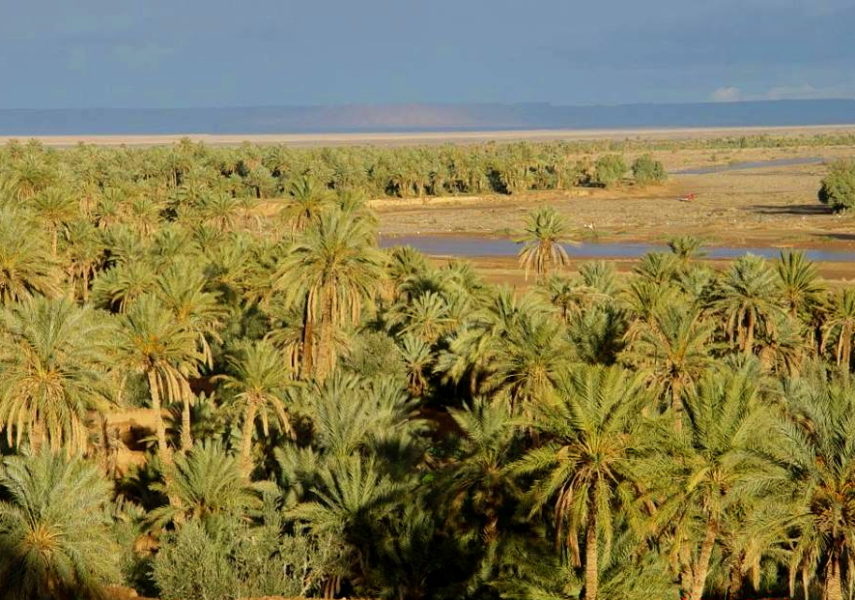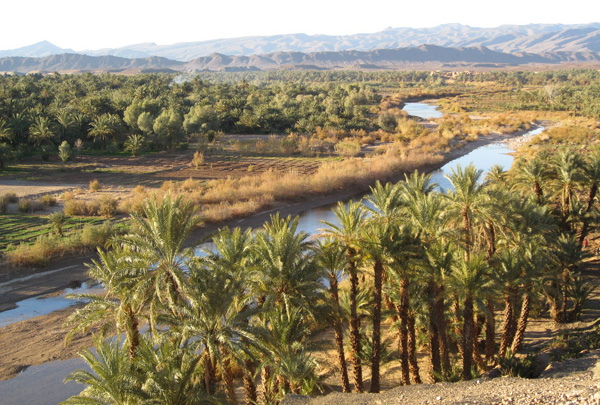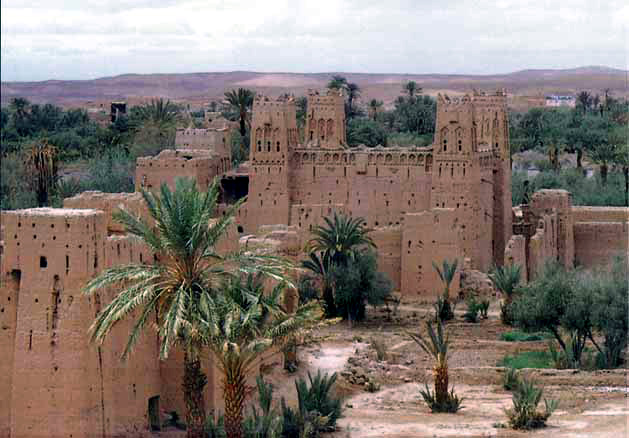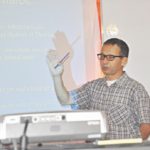 Lahcen Kabiri, one of our contributors within Med-O-Med Network and president of the AOFEP (Association Oasis Ferkla for the Environment and Patrimony), has been interviewed by the newspaper Liberation.ma about the upcoming COP22 and his knowledge and experience on the sustainable development in Moroccan oases.
Lahcen Kabiri, one of our contributors within Med-O-Med Network and president of the AOFEP (Association Oasis Ferkla for the Environment and Patrimony), has been interviewed by the newspaper Liberation.ma about the upcoming COP22 and his knowledge and experience on the sustainable development in Moroccan oases.
To be at the same time an expert and a committed actor is something unusual. Lahcen Kabiri gathers both roles, taking advantage of his experience skills, and bringing a unique point of view on the issue of the culture of the oases. Son of Ferkla, a university professor in the FST d’Errachidia and president of the association Ferkla, he combines theory, practice, and his passion for this particular field.
“Governance of water resources in oases”
-Liberation (L): On the eve of the COP 22 event, the project ‘Governance of water resources’ has just been implemented, what is this project about?
-Lahcen Kabiri (LK): Funded by the European Union, the project EU-NGO “for the institutional reinforcement of the environmental self-management, through the strengthening of the NGOs’ capacities”, started as a consortium with the micro financing program of the WEF (World Environment Fund) – UNDP Morocco, in the framework of the PACO3 project (concerted actions program for the oases 2013-2016). This project has been conducted by the Ferkla Partnership for the Environment and Heritage (AOFEP), as a focal point for the Moroccan associative network for the sustainable development of oases (RADDO).
Among the objectives defined, the project strengthens the civil society’s capacities in the management and implementation of environmental programs and projects, providing access to environmental information and knowledge, the technical support required, and the influence on policies and places linked to the water sector (especially, the law 10-95 on water).
The aim is to assess the impact and adequacy in relation to the cultural specificities of the oases, in the planning and management of water resources, providing, at the same time, with the necessary recommendations that need to be taken into account.
– L: Once the project has been completed, what are the main recommendations released?
-LK: Given that it is a major project, it is difficult to answer this question in a few lines. This intervention has contributed to the outline of the current problems affecting the different main actors in the oases, as it is the sustainable management of water resources. As a scarce resource, water is a lifetime issue. During the last two decades, the population relying on basic products that require the use of water resources has suffered a strong pressure.
The aim is to assess the impact and adequacy in relation to the cultural specificities of the oases, in the planning and management of water resources, providing, at the same time, with the necessary recommendations that need to be taken into account.
 In this framework, a first important recommendation is the analysis of both Law 10-95 and the draft Law 35-16 on water needs by our association, in order to guarantee the respect of the specific characteristics of the oases’ areas. On the other hand, we have worked on the establishment of a network of associations that focus their actions on issues related to water, building up a platform with representation from all areas of oases located in Morocco.
In this framework, a first important recommendation is the analysis of both Law 10-95 and the draft Law 35-16 on water needs by our association, in order to guarantee the respect of the specific characteristics of the oases’ areas. On the other hand, we have worked on the establishment of a network of associations that focus their actions on issues related to water, building up a platform with representation from all areas of oases located in Morocco.
-L: What has been the approach adopted during the management and implementation of this project?
-LK: We need to adopt an adequate approach for the intervention areas. In this sense, the selected areas of the oases have been the provinces of Figuig, Errachidia, Midelt, Tinghir, Ouarzazate, Zagora and Tata.
After January 2015, many actions have been carried out with a spirit of collaboration and effective participation.
After January 2015, many actions have been carried out with a spirit of collaboration and effective participation. We were aware, since the beginning, of the importance of involving all key actors and of incorporating all the potential aspects that could contribute to the achievement of the expected results. As a result, more than 250 actors of the culture of oases and related sectors have been directly involved in the implementation of the project. These key actors have been, among others, local development associations and the users of water for agricultural purposes —as they constitute the main target audience of the project—, cooperatives, economic interest groups, support agencies and/or affected by water management issues, research institutions, universities, entrepreneurs, researchers, students and the media. The activities carried out include training activities at a regional and local level and political briefings, regional and local workshops, political and media reports and expert panels. We have developed instruments that will have a direct and indirect impact in the future, such as the elaboration of position papers, the distribution of monthly newsletters and the launching of media campaigns.
-L: Are there available any reference documents on this issue?
-LK: Among the reference documents that can be found, there is a memorandum that includes all the recommendations of civil society organizations involved in the culture of the oases issue. This memorandum was presented to the different political parties in both Houses of Parliament and to the President of Draa – Tafilalet, regarding the adoption of the new version of the draft water legislation 36-15 by the Governing Council.
-L: Has this project been welcomed by the civil society?
-LK: This is a very interesting question, given that the bonds of trust continue to be the main link between the partnership created and involved in the project and the beneficiary local population. Undoubtedly, the participation of affected populations remains the key success factor of this project, as they must be involved in all phases of the project, including its planning, implementation and evaluation. Certainly, there are projects that cannot be successful without the participation of the affected people and without an adequate communication with the beneficiaries. Today we can be proud of the effective participation of the key actors, which has constituted an added value for this project, as has been the case in the khettaras.
L: How do you see the continuity of the project in a long term basis?
LK: We design and develop projects according to an internationally recognized methodology. More specifically, we start with a participatory assessment approach in collaboration with all key actors and beneficiaries. The operational management and the empowerment of workshops have facilitated the transference of knowledge and the participation of experts. Its continuity is guaranteed by the urgent need to save the oases and the lasting life in these natural areas where the man is the main responsible for the degradation of these fragile ecosystems.
The Moroccan oases and the climate change
-L: In what condition are currently the Moroccan oases and what public policies need to be adopted?
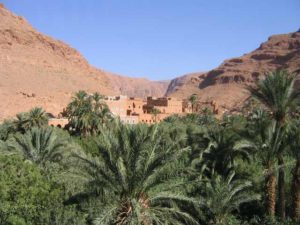 -L K: In my humble opinion, I would say that the situation is alarming. Undoubtedly, there has been an effort for protecting the oases, but it has been inadequate, when compared to the deficits seen in the field. The main cause of the insufficient impact on the actions taken to safeguard the oases is the lack of coordination both in the research programs, and among the various institutional actors, international and local population. However, we must also highlight the lack of selection of adequate programs to develop in these areas, the increasing extension of the oases and the problem of desertification and siltation that are threatening them. We need to launch a global action, in a spirit of coordination and cooperation, in order to halt the degradation, and to save the life and heritage of the oases, promoting, at the same, global actions for the conservation of an ecosystem respectful with the environment.
-L K: In my humble opinion, I would say that the situation is alarming. Undoubtedly, there has been an effort for protecting the oases, but it has been inadequate, when compared to the deficits seen in the field. The main cause of the insufficient impact on the actions taken to safeguard the oases is the lack of coordination both in the research programs, and among the various institutional actors, international and local population. However, we must also highlight the lack of selection of adequate programs to develop in these areas, the increasing extension of the oases and the problem of desertification and siltation that are threatening them. We need to launch a global action, in a spirit of coordination and cooperation, in order to halt the degradation, and to save the life and heritage of the oases, promoting, at the same, global actions for the conservation of an ecosystem respectful with the environment.
-L: In this context, how will climate change affect the oases areas?
-LK: Although climate change is a universal problem, it is increasingly affecting the oases areas due to the human intervention in nature. Before answering this question, it is necessary to take into account that the oases are originally a fragile ecosystem that constantly suffers from climatic changes, such as droughts, floods, silting, etc. These phenomena have always exist, the only novelty is the irresponsible relationship of men with the thousands of oases that exist today, which results in the incapacity to cope with this climate changes.
Previously, our ancestors preserved the environment by following a sustainable way of life, based on the respect of water resources and biodiversity. Today this has changed. As a consequence, everyone must reconsider the issue of the oases from a new perspective.
COP 22 will certainly be an opportunity for us, as civil associations, to launch public awareness actions affecting all the activities taken in defense of the oases areas. It is necessary to inform the general population about the oases, their characteristics, their products, culture and heritage.
-L: What role does civil society play in relation to climate change?
-LK: It plays a prominent role. It is time that all associations understand scientifically these phenomena, in order to raise public awareness and to mobilize against these threats. The associations must elaborate programs and action plans with the aim of developing global actions against the public policies negative for the environment, and to promote the right the population has to carry out appropriate projects that help to guarantee the preservation of these specific areas.
-L: What are your expectations for the upcoming COP 22, which will take place next November in Marrakech?
-LK: COP 22 will certainly be an opportunity for us, as civil associations, to launch public awareness actions affecting all the activities taken in defense of the oases areas. It is necessary to inform the general population about the oases, their characteristics, their products, culture and heritage.
In addition, this summit will be an opportunity to meet with activists, experts and donors from all around the world, promoting the exchange of experiences and the debate on how to fight against such a negative phenomenon.
 Since we cannot remain silent on a key issue as important as this one, all actors related to the oases culture will need to participate in Marrakech summit. However, they are not making the necessary consultations in order to highlight the problem of oases. As a result, Ministries, institutions, external services, civil actors, organizations involved in the field, etc. will be unprepared, and without a common and well-crafted position that would allow to take advantage of this great opportunity for giving more visibility to this problem. I think this is not the most appropriate way to prepare any relevant international summit or meeting.
Since we cannot remain silent on a key issue as important as this one, all actors related to the oases culture will need to participate in Marrakech summit. However, they are not making the necessary consultations in order to highlight the problem of oases. As a result, Ministries, institutions, external services, civil actors, organizations involved in the field, etc. will be unprepared, and without a common and well-crafted position that would allow to take advantage of this great opportunity for giving more visibility to this problem. I think this is not the most appropriate way to prepare any relevant international summit or meeting.
Marrakech should be an opportunity to defend our land, our culture, our heritage and to guarantee its sustainability for the future generations. Therefore, it is imperative to think collectively and globally, to promote effective local action for climate justice. Global thinking for an effective local action that allows the achievement of climate justice remains the main objective of all actions of civil society and should be imposed in a concerted manner to all policymakers, at all levels.
Translation: Myriam de la Cavada. FUNCI
This post is available in: English Español

